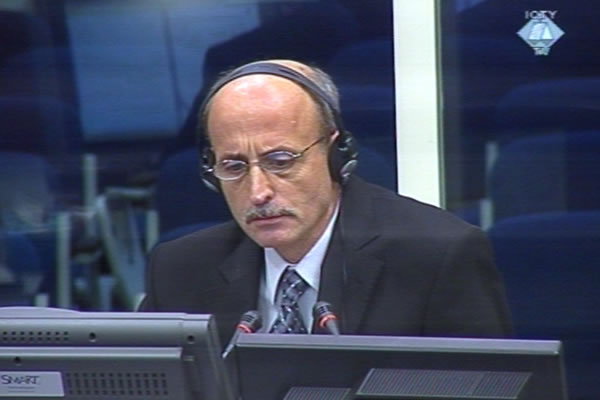Home
GENOCIDE IN SREBRENICA CONTESTED AGAIN
Karadzic’s defense witness Tomislav Savkic contends that in mid-July 1995, when he was the president of Milici municipality, he saw ‘hundreds and thousands’ of the bodies of Bosnian Muslims in the hills in the Konjevic Polje area. He was told that most of them had been killed as they fought each other, while some died as they tried to cross mine fields and in clashes with the Serb army. The Bosnian Serb military and police documents, however, don’t report any such incidents
 Tomislav Savkic, defence witness of Radovan Karadzic
Tomislav Savkic, defence witness of Radovan Karadzic In his evidence in Radovan Karadzic’s defense, Tomislav Savkic, the wartime president of Milici municipality, in Eastern Bosnia tried to convince the judges that the bodies of ‘hundreds and thousands’ of Muslims from Srebrenica he saw in mid-July 1995 were not victims of mass executions.
In his statement to the defense team and in his replies to Karadzic Savkic said that on 11 July 1995 he received information that Muslim units fleeing Srebrenica had broken through the defense line of the Milici Battalion in the hills near Konjevic Polje, on the road near Bokcin Potok. Some days later, the witness visited the brigade and, as he put it, saw bodies of ‘more than 2,000’ dead Muslims on the road between Bokcin Potok, Bratinjci and Sandici.
His soldiers told him how the Muslims had died, the witness said. The scenario they presented was this: first, as the Muslims fled from Srebrenica, they entered a mine field where some of them were killed. Then, the remaining Muslims clashed with the Milici Battalion. The battalion opened a breach in their line and let them pass through, but still, some of the Muslims were killed there. After that, the Muslim soldiers fought each other. This, the witness was told, happened because as they fought the Serb army, the elements of the Muslim unit could no longer communicate with each other and became disoriented: they fired at each other throughout the night. The result was thousands of bodies littering the area.
In the cross-examination, prosecutor Sutherland showed the witness some documents from the Bosnian Serb army and police. The documents say nothing about any fighting with the Muslims forces. A Drina Corps report states that on 11 July 1995 it was ‘quiet in the zone of Konjevic Polje and Nova Kasaba’. The police forces commander Ljubomir Borovcanin reported that several thousand Muslims had been captured but there was no fighting. The witness denied this strenuously, arguing that Borovcanin ‘has no clue’.
The prosecutor then showed him a video recording taken by Belgrade journalist Zoran Petrovic Pirocanac on 13 July 1995. The footage showed Serb soldiers on the road near Sandici forcing captured Muslims to invite their compatriots to surrender. The captives were wearing civilian clothes and there were still no bodies to be seen. According to the witness, that part of the road ‘had nothing to do whatsoever’ with the location he described.
Savkic also denied that the Bosnian Serb forces committed any crimes in the Vlasenica and Milici area during the entire war. The witness said that ‘foreign troops’ – some ‘external’ units – were responsible for the murder of more than 60 Muslims in the village of Zaklopaca, near Vlasenica, on 16 May 1992. As the witness said, the JNA soldiers passed through that area and rested there for a while; when they heard about the crimes committed by the Muslims against Serb civilians, there was retaliation. It remained unclear who the ‘foreign troops’ were: the JNA or some other units. The witness nevertheless explained that it was a ‘random attack’ in which fire was opened on both Serb and Muslim houses. The prosecutor then asked the witness how it was possible that there were only Muslim casualties in the random fire. The witness replied that one of next defense witnesses – Bozidar Trsic – would be able to explain it better. Trsic actually recounted the story to Savkic. In the re-examination, Karadzic showed some documents from the Bosnian authorities which indicate that some victims were members of the Muslim Territorial Defense. One of the prosecution witnesses, Sead Hodzic, survived the execution in Zaklopaca. Hodzic said that people were taken out of their homes. Some children younger than 10 were among the victims.
